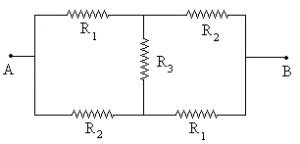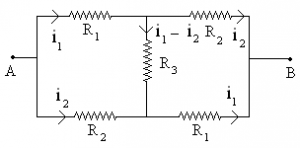To find the equivalent resistance between A and B. After marking the junction
After marking the junction Hence equivalent resistance between A and B is RAB = 3R/5.
Hence equivalent resistance between A and B is RAB = 3R/5.
Nodal analysis:
To find the current distribution in arms To solve this one must assume the potential of one node equal to zero and then corresponding other potentials as marked in following diagram
To solve this one must assume the potential of one node equal to zero and then corresponding other potentials as marked in following diagram The solving equation for the unknown V is \(\frac{V-{{E}_{1}}}{{{R}_{1}}}+\frac{V-{{E}_{2}}}{{{R}_{2}}}+\frac{V}{{{R}_{3}}}=0\)
The solving equation for the unknown V is \(\frac{V-{{E}_{1}}}{{{R}_{1}}}+\frac{V-{{E}_{2}}}{{{R}_{2}}}+\frac{V}{{{R}_{3}}}=0\)
Symmetry method:
(a) Folding symmetry: (b) Input output symmetry: In such cases the current distribution follows the symmetry as shown below
(b) Input output symmetry: In such cases the current distribution follows the symmetry as shown below
 Example: A battery of 10 V and negligible internal resistance is connected across the diagonally opposite corners of a cubical network consisting of 12 resistors each of resistance as shown in the figure. Determine the equivalent resistance of the network and the current along each edge of the cube.
Example: A battery of 10 V and negligible internal resistance is connected across the diagonally opposite corners of a cubical network consisting of 12 resistors each of resistance as shown in the figure. Determine the equivalent resistance of the network and the current along each edge of the cube.  Solution: The network is not reducible to a simple series and parallel combinations of resistors. There is, however, a clear symmetry in the problem which we can exploit to obtain the equivalent resistance of the network.
Solution: The network is not reducible to a simple series and parallel combinations of resistors. There is, however, a clear symmetry in the problem which we can exploit to obtain the equivalent resistance of the network.
The paths, AD and AB are obviously symmetrically placed in the network. Thus, the current in each must be the same, say, I. Further, at the corners, B and D, the incoming current I must split equally into the two outgoing branches. In this manner, the current in all the 12 edges of the cube are easily written down in terms of I, using Kirchhoff’s first rule and the symmetry in the problem. Next take a closed loop, say, and apply Kirchhoff’s second rule:
– IR – ½ IR – IR + ε = 0
Where R is the resistance of each edge and the emf ε of battery.
Thus, ε = 15/2 IR, Req = ε/31 = 5/6R
The equivalent resistance of the network is for R = 1Ω, Req = 5/6 Ω and for ε = 10V the total current (= 3I) in the network is 3I = 10V/ (5/6)Ω = 12A i.e., I = 4A.
The current in each edge can now be read off from the figure.
